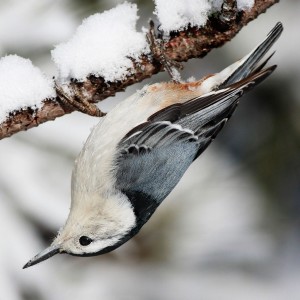
White Breasted Nuthatch feeds upside down on trees and the stems of plants. Its winter diet is dominated by seed. When it warms up, they love insects.
To most gardeners, fall is a time to clean up and prune their lawns and gardens for next season; winter is a time to reflect and plan for the year ahead. But did you know you can skip tidying up the and enjoy your garden even in the dead of winter? As the last leaves and fall blossoms fade away with the daylight, the barren remnants of once flourishing trees and gardens remain to face the cold winter months. They may not be as vibrant and lively as they once were, but the skeletons left behind play a valuable role for the survival of winter wildlife. Birds, insects, and critters will take refuge in stiff frozen gardens as they rely heavily on the food source and shelter it provides to survive and thrive until the spring thaw. By putting down the rake and pruning shears, you have the opportunity to create your own nature reserve by increasing biodiversity in your garden to enjoy all year long.
Instead of raking and bagging your leaves, which no one likes to do anyways, you can reuse them to create a free mulch to improve water retention, improve soil fertility and suppress weed growth in your garden. It can also be used to create a habitat for wildlife by building brush piles to provide food, shelter, and nesting material. Many moth and butterfly caterpillars will overwinter in fallen leaves until emerging when conditions are right. Leaving deadheading and pruning until the spring allows you to provide a prime food and shelter source for birds and critters. By planting Purple Coneflower, Black Eyed Susans, Joe Pye Weed, and Ironweed can provide a reliable source of food and shelter when they are not deadheaded or pruned. By using a few of these tips and planting flowers and shrubs to provide sanctuaries for wildlife, you can have the opportunity to create a wildlife winter garden reserve to bring diversity, color, and life back to your garden year round.
Photo Credit: Mdf of Wikimedia. This image was Wikimedia Image of the Day on March 17, 2007, and was a contender for Image of the Year 2007.





